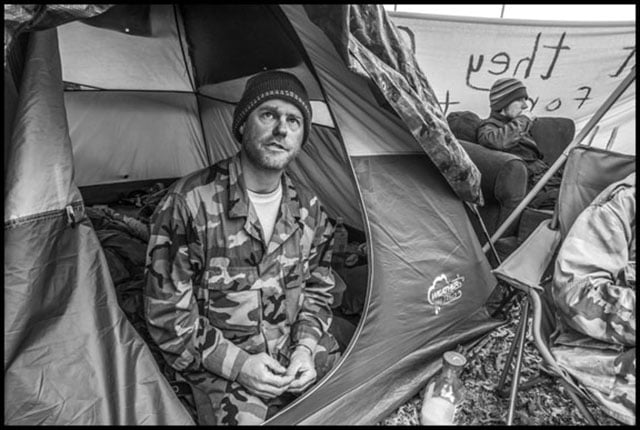
Part of the Series
Beyond the Sound Bites: Election 2016
Honest, paywall-free news is rare. Please support our boldly independent journalism with a donation of any size.
Berkeley, California — By the time you read this, Berkeley’s intentional mobile homeless community will probably have been forced to migrate again, in yet one more forcible relocation.
A week ago, at five in morning, six city trucks and a U-Haul van pulled up at the tent encampment on a peaceful, leaf-covered median in the middle of south Berkeley’s Adeline Street. Each truck had two municipal workers on board. Half a dozen police patrol cars accompanied them, red and blue lights flashing in the dark.
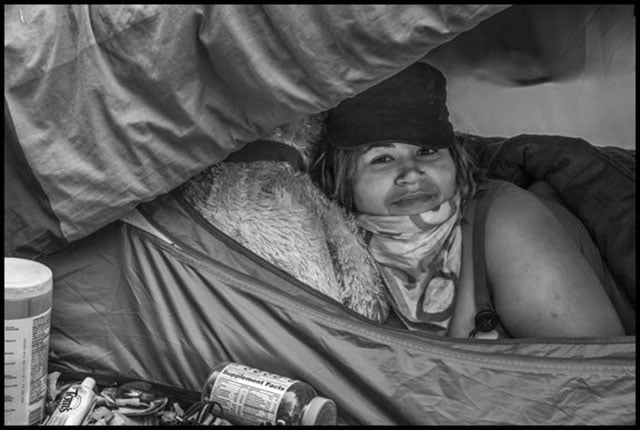 MuZiK, a resident of the occupation, in her tent in the middle of Adeline Street. (Photo: David Bacon)
MuZiK, a resident of the occupation, in her tent in the middle of Adeline Street. (Photo: David Bacon)
Brad, one of the camp residents, sounded the warning. Sleepy tent-dwellers quickly began to text supporters, warning that the city was threatening once again to throw tents and belongings into trucks and force people to leave.
“We went into delaying tactics while we got community support mobilized,” recalls Mike Zint, one of the leaders of this homeless community. “That doesn’t stop them, but every time this happens we get more support. So they sat there in their trucks for the next six hours — a dozen city workers and a code compliance officer, all on overtime. They took seven cops off patrol. And in the end, after all the arguments, we only moved about 200 feet, across the street. And how much did that cost?”
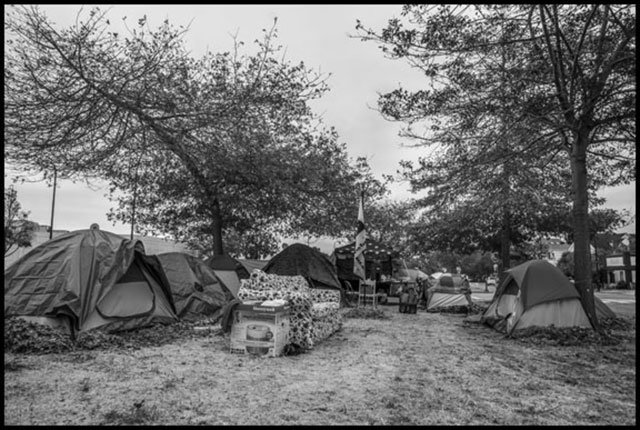 The occupation on the grass median in the middle of Adeline Street. (Photo: Davif Bacon)
The occupation on the grass median in the middle of Adeline Street. (Photo: Davif Bacon)
This homeless community is not just a group of people trying to find a place to live. They call themselves an “intentional community” with a political purpose — forcing homelessness into public debate and defending the rights of homeless people. Homeless activists are fighting for the same things in many cities. Together, they are beginning to have an impact on local policies toward “unhoused people” (people who have no formal housing). Political participation by homeless communities is giving them a voice in the national debate over homelessness as well.
Several weeks ago a group of people in this community “popped tents,” as they say, in front of the Impact HUB, an office where the city has decided to centralize most services for homeless people. They protested an intake process they say screens out applicants for housing. Writing in the local Street Spirit newspaper, Dan McMullan, who runs the Disabled People Outside Project, recalls, “I spent a week trying to get help for a disabled woman in a wheelchair and had to watch as she slept in front of the women’s shelter one night, and the Harrison House the next. But she could not get in. I couldn’t believe it.” He goes on to say that a HUB employee said the woman didn’t fit the intake criteria, and that she was denied reconsideration of her case.
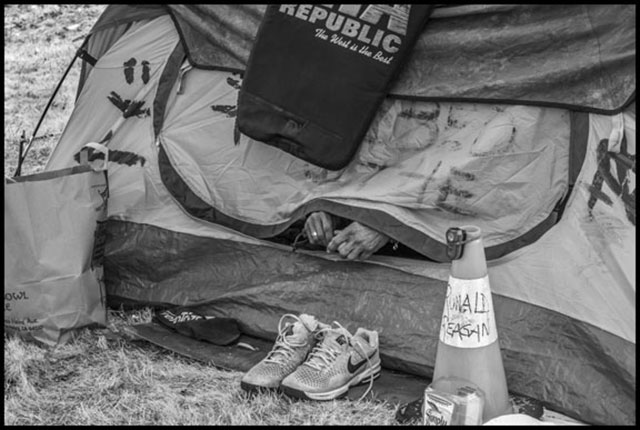 Ronald Vargas sticks his hands out of the tent in the morning, looking for his shoes. (Photo: David Bacon)
Ronald Vargas sticks his hands out of the tent in the morning, looking for his shoes. (Photo: David Bacon)
But the community’s objections go beyond the immediate denial of services. They condemn the way the city treats homeless people as victims — as passive recipients of services — rather than people capable of governing themselves.
For weeks their camp has moved from place to place, in a peregrination Zint calls the Poor Tour. “It’s a mobile occupation that can pop up anywhere,” he explains. “We’re exposing the fact that there is no solution — nothing but exposure for the homeless. And exposure [the physical cost of sleeping outside] is killing a lot of people.”
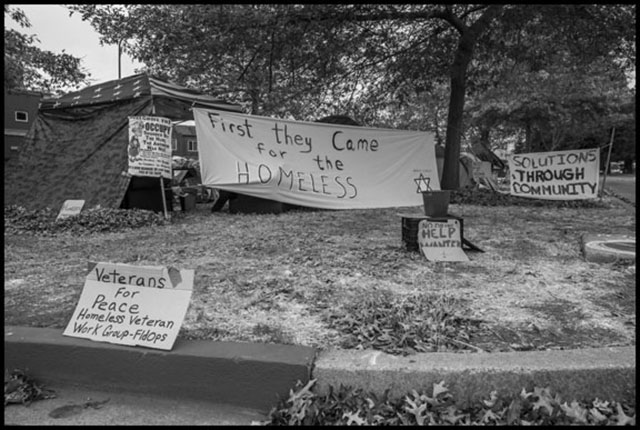 Banners at the Adeline Street occupation, including the banner for “First They Came for the Homeless.” (Photo: David Bacon)
Banners at the Adeline Street occupation, including the banner for “First They Came for the Homeless.” (Photo: David Bacon)
A recent death was one of the reasons for launching the Poor Tour. On September 19, Roberto Benitas, a day laborer, died sleeping in a doorway. Benitas worked minimum wage jobs, standing in the bitter cold each morning in front of nearby lumberyards, trying to flag down contractors in their pickup trucks. Getting an occasional day’s work was never enough to pay Berkeley’s skyrocketing rents.
McMullan angrily charged, “Not a cent went into Social Security for the aging worker. When he died in a doorway of the defunct U-Haul rental shop at Allston Way and San Pablo Avenue, it took a day or so for anyone to even notice.” McMullen and a progressive city council candidate organized a memorial for Benitas, and the Poor Tour started days later.
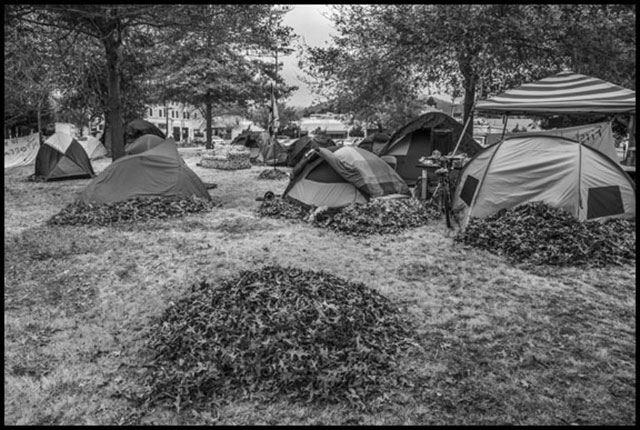 The occupation on the grass median in the middle of Adeline Street. (Photo: David Bacon)
The occupation on the grass median in the middle of Adeline Street. (Photo: David Bacon)
Another reason for the tour is the November election, and an effort by this group of activists to use it to assert themselves politically. For over two years, homeless activists have been increasingly involved in Berkeley city politics.
The roots of this mobile occupation actually go back to Occupy San Francisco, and the decision by some of its residents to cross San Francisco Bay to Berkeley in the wake of Occupy’s dispersal. At first, they lived for months in tents in front of a local Staples store. Then, two years ago, Zint and others set up an encampment in front of Berkeley’s main post office.
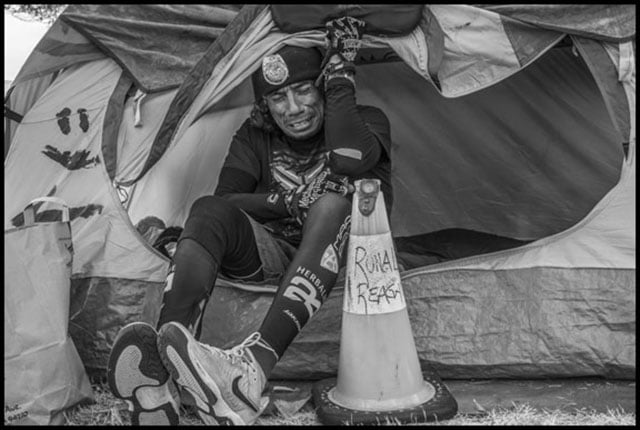 Ronald Vargas begins to cry as he talks about the hard times in his life. (Photo: David Bacon)
Ronald Vargas begins to cry as he talks about the hard times in his life. (Photo: David Bacon)
The Post Office occupation became a political weapon, the most visible part of a broader coalition that successfully fought the sale of the New Deal-era building to private developers. That coalition eventually included even the mayor and the city administration, which filed suit to block the sell-off.
The community of tents, tarps and literature tables on the steps lasted for over a year and a half, before the Post Office Police finally drove the tent dwellers away. Postal authorities then built an imposing fence of iron bars around the empty space where the tents had been, to keep anyone from ever setting foot again on that section of sidewalk.
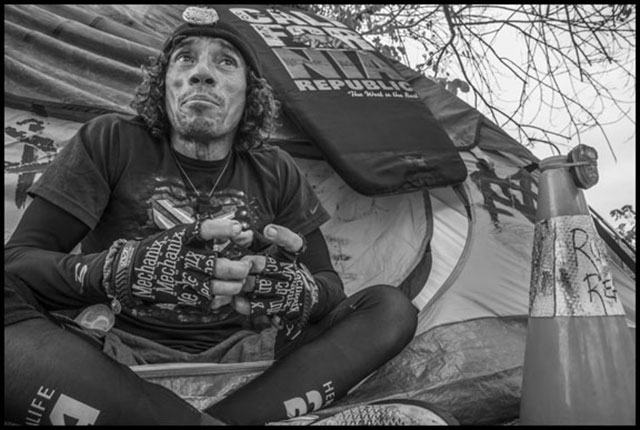 Ronald Vargas, a Nicaraguan refugee, is the occupation’s artist and makes many of the protest banners. He calls himself Ronald Reagan as a sarcastic comment (because Reagan was responsible for the “contra war” against Nicaragua’s Sandinista government). (Photo: David Bacon)
Ronald Vargas, a Nicaraguan refugee, is the occupation’s artist and makes many of the protest banners. He calls himself Ronald Reagan as a sarcastic comment (because Reagan was responsible for the “contra war” against Nicaragua’s Sandinista government). (Photo: David Bacon)
That certainly felt like revenge to activists. While allied against the Post Office, the encampment’s residents have increasingly criticized the current city administration. They charge that Berkeley has given developers a green light to build a wave of market-rate housing that is gentrifying the city, and at the same time creating more homelessness.
They point to a recent study by the San Francisco Planning Commission, which found that every set of 100 market-rate condominiums required the labor of about 43 working-class families to maintain them and support their residents. Not only don’t the condos create housing for poorer residents, but they increase housing demand at the bottom of the market, without coming up with any places for people to live. The net result is the increasing displacement of low-income people.
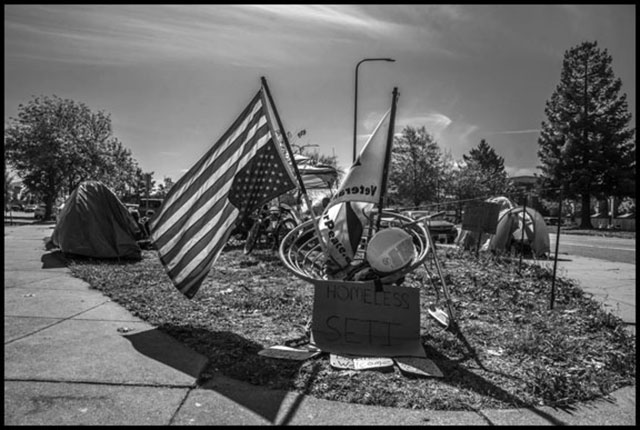 After being forced by police to disband one camp on the grass median in the middle of Adeline Street, homeless community activists set up another across the street. (Photo: David Bacon)
After being forced by police to disband one camp on the grass median in the middle of Adeline Street, homeless community activists set up another across the street. (Photo: David Bacon)
The Post Office coalition broke down entirely when conservative members of the city council, backed by the Downtown Business Association, pushed through an ordinance that restricts the space for the belongings of homeless people on public sidewalks. During the debate, the Post Office camp activists set up a new occupation, called Liberty City, in front of the old City Hall to make their opposition visible.
In an interview for Truthout, MuZiK, one of those displaced in the uprooting of the camp on Adeline Street, envisioned a growing use of occupations. MuZiK noted that, while it might make people uncomfortable, “if our protest is anything other than a short ‘here today, gone tomorrow’ sort of deal … we got a lot of time on our hands, so don’t hate it if we choose to spend it fighting for what’s right!”
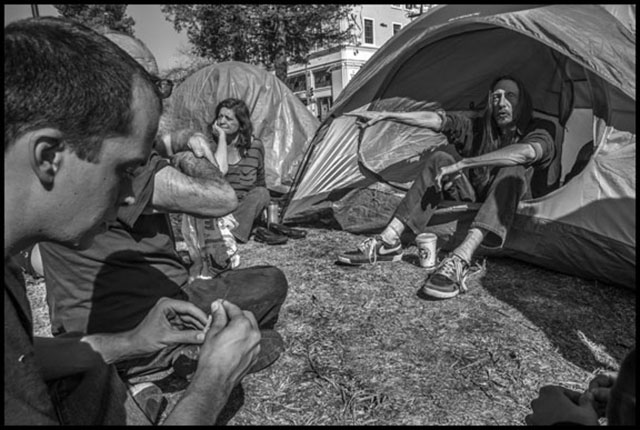 Mike Zint a leader of the homeless occupation, at an informal meeting outside his tent. (Photo: David Bacon)
Mike Zint a leader of the homeless occupation, at an informal meeting outside his tent. (Photo: David Bacon)
In the wake of the sit-lie battle, another resident of the occupation, Mike Lee, declared himself a candidate for mayor. His campaign dramatizes the idea that homeless people should be given space to set up tents and create a self-governing community. At the Post Office and Liberty City, “What’s being created is an intentional community,” Lee explains, “where people come together and intentionally create an entity for mutual aid and voluntary cooperation, so that they can survive together and solve their own problems. Homeless people have always formed communities, whether we were considered ‘hobos’ or homeless people or just ‘bums.’ Homo sapiens are very social animals. We come together naturally.”
At the Post Office encampment, voter registration forms appeared on the tables in front of the tents. “We’re homeless and we vote!” Lee says. “There is a political purpose here, to change the way public policy is crafted and implemented. As homeless people we are the true experts. Organizing is the solution to homelessness, and the people responsible for solving homelessness are the homeless themselves.” Lee has put forward detailed plans and budgets, showing how the city could use a vacant community center to house working homeless people, and establish areas where others could set up tents or build “tiny houses.”
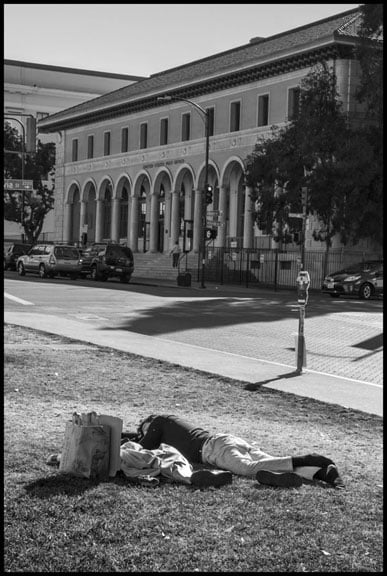 A homeless man sleeps across the street from the Post Office, where the homeless camp used to be. It is now an empty space surrounded by iron bars — the people who used to live there sleep on the grass or elsewhere. (Photo: David Bacon)Meanwhile, city politics have become very sharply divided, which is reflected in the current mayoral election. The city’s progressive bloc, a minority on the city council, has two candidates for mayor. Councilmember Jesse Arreguin is more heavily favored and is the city’s first Latino elected official, endorsed by local unions and Bernie Sanders. Fellow Councilmember Kriss Worthington earned the loyalty of progressives by showing up on picket lines and at demonstrations for years.
A homeless man sleeps across the street from the Post Office, where the homeless camp used to be. It is now an empty space surrounded by iron bars — the people who used to live there sleep on the grass or elsewhere. (Photo: David Bacon)Meanwhile, city politics have become very sharply divided, which is reflected in the current mayoral election. The city’s progressive bloc, a minority on the city council, has two candidates for mayor. Councilmember Jesse Arreguin is more heavily favored and is the city’s first Latino elected official, endorsed by local unions and Bernie Sanders. Fellow Councilmember Kriss Worthington earned the loyalty of progressives by showing up on picket lines and at demonstrations for years.
Leading the conservative opposition is Laurie Capitelli, a real estate agent whose campaign is well funded by property owners and developers. By mid-October the “independent” National Association of Realtors PAC, having found a way around the city’s $250 limit on direct campaign contributions, had channeled $60,382 into Capitelli campaign mailers.
Berkeley is one of many cities that has adopted ranked-choice voting in recent years. This helps the homeless political effort to reach out for allies. Arreguin and Worthington both ask supporters to vote for the other as their second choice in the ranked voting system. Now Lee has asked his constituency to vote for Arreguin as second choice, and Worthington as third choice. In this way, ranked choice voting allows people to support the political demands voiced by a candidate of homeless people, and then to support those progressive candidates who actually have the greatest chance of winning office.
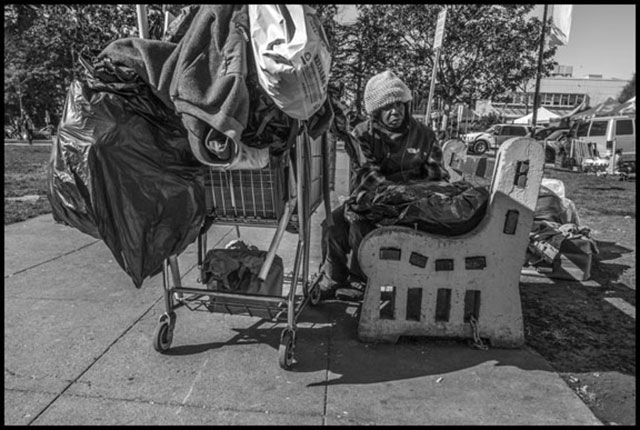 After being expelled from the Post Office camp and Liberty City, many homeless people began living in Provo Park, across the street from City Hall. The police later dispersed the people here also. (Photo: David Bacon)
After being expelled from the Post Office camp and Liberty City, many homeless people began living in Provo Park, across the street from City Hall. The police later dispersed the people here also. (Photo: David Bacon)
At the height of a recent rainstorm, Arreguin came out to check on the welfare of the people in the tents, which earned him Lee’s support. Worthington has come by the occupations several times in the past. Ultimately, Arreguin says, the city needs to hear from homeless people themselves and treat them as normal members of the body politic. “We do have a crisis, and all options should be on the table,” he said in an interview last year. “Berkeley should consider a temporary encampment until we have more permanent housing. People need a place to go.”
There is no question but that homelessness is an issue in Berkeley’s city election. And while the presidential debates avoided it, homelessness has become a national issue as well. The explosion in the number of homeless people nationwide has led both to the passage of anti-homeless legislation in some cities and to the recognition of homeless encampments in others. That explosion has not led yet to a broad movement for building public housing on a massive scale to eliminate homelessness. But organized homeless people with a strong voice could help to create one. Such a movement would depend as well on alliances with the broader communities in which homeless people live.
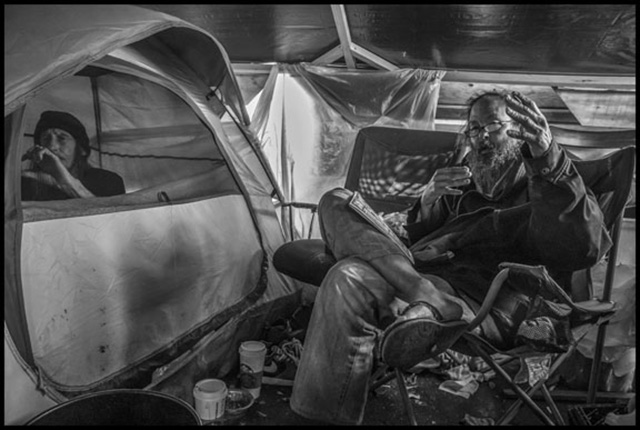 Mike Lee and Mike Zint (in the tent) in the camp outside the Berkeley Post Office, originally established to protest the sale of the Main Post Office building. The Post Office Police demolished the camp and evicted the residents a few weeks after the photo was taken. (Photo: David Bacon)
Mike Lee and Mike Zint (in the tent) in the camp outside the Berkeley Post Office, originally established to protest the sale of the Main Post Office building. The Post Office Police demolished the camp and evicted the residents a few weeks after the photo was taken. (Photo: David Bacon)
Media depictions often portray neighbors incensed over the presence of homeless people. The experience of the Poor Tour, however, is different. Residents of the mobile occupation have been careful to reach out to the neighborhoods that surround the camps. “We’re very fortunate that we have the support of the community — we wouldn’t be able to pull off this tour without them,” Zint says. “The city is so corrupt — sniffing around the developers’ money. It’s time that the community figures out what’s going on, stands up and fights back with us.”
To keep their support, the camp has set basic rules. “This is a community, not a drug camp,” Zint emphasizes. “We don’t have a Porta Potty, but we still manage to be sanitary. No drugs or alcohol. Treat each other with fairness and respect. Be mindful of the neighbors because they’re the ones we draw our support from.”
The activists and their umbrella organization, First They Came for the Homeless, have a website and a Facebook page. James Cartmill, who lives in the tents, and Sarah Menefee, a long-time homeless rights activist who is a near-constant presence at the camp, have taken and posted hundreds of photographs showing camp life from the inside, and the confrontations with the police and city.
The occupations are decorated with posters and banners created by Nicaraguan refugee Ronald Vargas Gonzalez, whose sarcastic camp nickname is Ronald Reagan (who was responsible for the “contra war” against Nicaragua’s Sandinista government). “I use what I have inside me,” he explains. “I analyze the society. I analyze being homeless. In each drawing I work to make society recognize that the homeless are human. Society says homeless means garbage, but homeless is human. Society has to give us respect.”
Vargas credits the community he’s found with fellow tent dwellers with keeping him alive. “The people here are like my roots, a connection to life. You can tell them everything – the good and the bad. What you’ve lost in this life, and what you’ve found.”
© Copyright David Bacon
Press freedom is under attack
As Trump cracks down on political speech, independent media is increasingly necessary.
Truthout produces reporting you won’t see in the mainstream: journalism from the frontlines of global conflict, interviews with grassroots movement leaders, high-quality legal analysis and more.
Our work is possible thanks to reader support. Help Truthout catalyze change and social justice — make a tax-deductible monthly or one-time donation today.